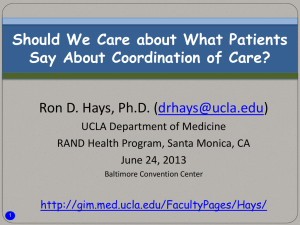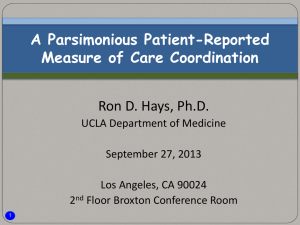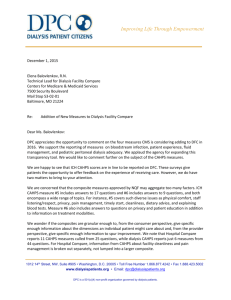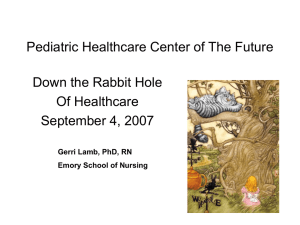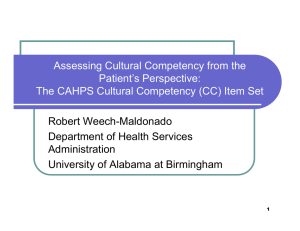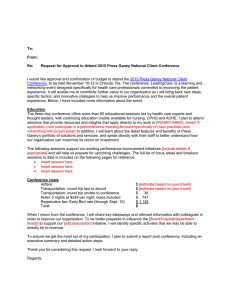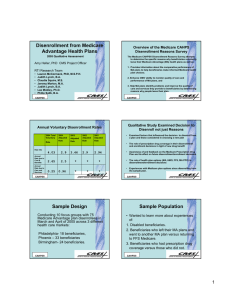C R e s e a r c h ... Consumer Choice and Health Care Quality
advertisement
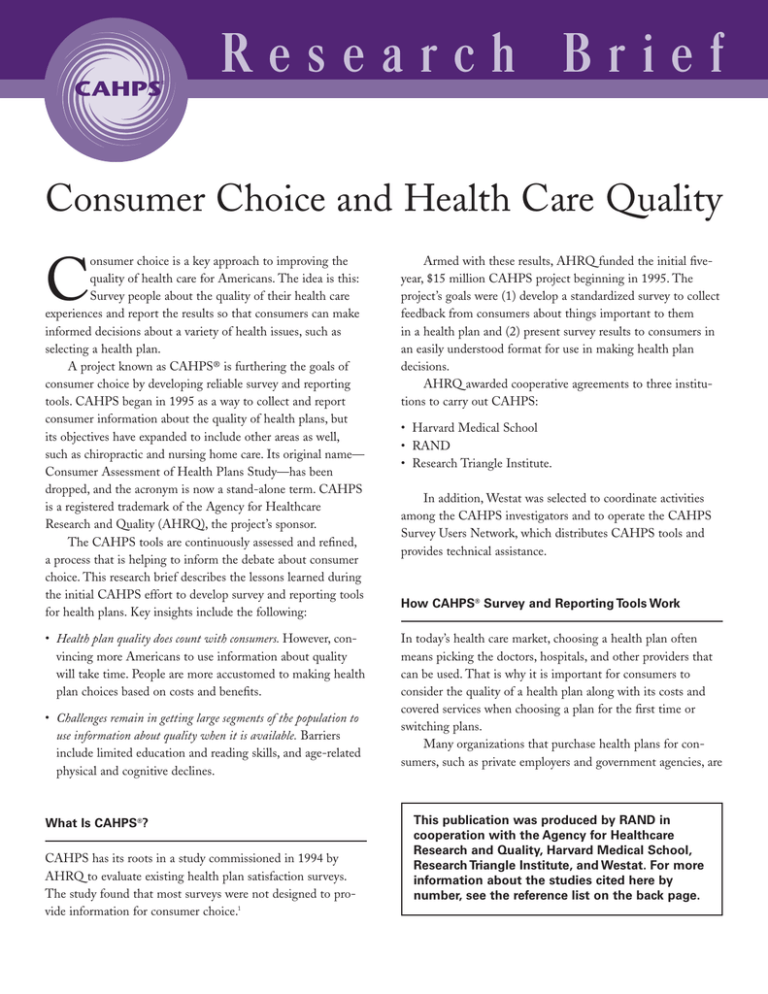
® ® Research Brief Consumer Choice and Health Care Quality onsumer choice is a key approach to improving the quality of health care for Americans. The idea is this: Survey people about the quality of their health care experiences and report the results so that consumers can make informed decisions about a variety of health issues, such as selecting a health plan. A project known as CAHPS® is furthering the goals of consumer choice by developing reliable survey and reporting tools. CAHPS began in 1995 as a way to collect and report consumer information about the quality of health plans, but its objectives have expanded to include other areas as well, such as chiropractic and nursing home care. Its original name— Consumer Assessment of Health Plans Study—has been dropped, and the acronym is now a stand-alone term. CAHPS is a registered trademark of the Agency for Healthcare Research and Quality (AHRQ), the project’s sponsor. The CAHPS tools are continuously assessed and refined, a process that is helping to inform the debate about consumer choice. This research brief describes the lessons learned during the initial CAHPS effort to develop survey and reporting tools for health plans. Key insights include the following: Armed with these results, AHRQ funded the initial fiveyear, $15 million CAHPS project beginning in 1995. The project’s goals were (1) develop a standardized survey to collect feedback from consumers about things important to them in a health plan and (2) present survey results to consumers in an easily understood format for use in making health plan decisions. AHRQ awarded cooperative agreements to three institutions to carry out CAHPS: • Health plan quality does count with consumers. However, convincing more Americans to use information about quality will take time. People are more accustomed to making health plan choices based on costs and benefits. In today’s health care market, choosing a health plan often means picking the doctors, hospitals, and other providers that can be used. That is why it is important for consumers to consider the quality of a health plan along with its costs and covered services when choosing a plan for the first time or switching plans. Many organizations that purchase health plans for consumers, such as private employers and government agencies, are C • Challenges remain in getting large segments of the population to use information about quality when it is available. Barriers include limited education and reading skills, and age-related physical and cognitive declines. What Is CAHPS®? CAHPS has its roots in a study commissioned in 1994 by AHRQ to evaluate existing health plan satisfaction surveys. The study found that most surveys were not designed to provide information for consumer choice.1 • Harvard Medical School • RAND • Research Triangle Institute. In addition, Westat was selected to coordinate activities among the CAHPS investigators and to operate the CAHPS Survey Users Network, which distributes CAHPS tools and provides technical assistance. How CAHPS® Survey and Reporting Tools Work This publication was produced by RAND in cooperation with the Agency for Healthcare Research and Quality, Harvard Medical School, Research Triangle Institute, and Westat. For more information about the studies cited here by number, see the reference list on the back page. helping the decisionmaking process by sponsoring a CAHPS survey. The sponsor typically hires a vendor to administer the CAHPS survey to a sample of current plan enrollees. The survey results are then analyzed and compiled into report cards that people can use to make health plan decisions. The Center for Medicare & Medicaid Services, for example, sponsors CAHPS surveys, and the resulting health plan report cards are available to all Medicare beneficiaries. Other CAHPS sponsors include the U.S. Office of Personnel Management and the Department of Defense; state Medicaid offices; private employers and business coalitions; and health plans (for internal quality improvement or for accreditation). The CAHPS survey and reporting tools are in the public domain and are available without cost through the CAHPS Survey Users Network (see “For more information” on back). Based on additional research and refinements, an updated version of the core survey questions will be available in the fall of 2002. In addition, the beta version of a questionnaire about people’s experiences with group medical practices is available. Other CAHPS surveys in various stages of development will expand consumer assessments into such areas as dental, chiropractic, and nursing home care, as well as behavioral health care. CAHPS® Reporting Tools CAHPS provides software that analyzes answers to the survey questions and summarizes the results for each of the five categories of care. The software also generates the global ratings of the health plan and the care provided. These results can then be assembled into a report card for consumers, either in a printed form or in an interactive computer display. CAHPS provides the following two suggested formats for the report cards, which can be modified for different audiences: CAHPS® Surveys Unlike many existing consumer surveys that only ask people how satisfied they are with their health plan, a CAHPS survey probes deeper, posing questions that are meaningful to individuals (see sidebar, “CAHPS Survey Questions,” on page 5). The survey asks people to rate their health care and health plan overall (called global ratings) and to report on their health care experiences. Results are summarized in five different aspects of care: • • • • • • Star charts. A three-star format shows consumers how a particular health plan compares against all others being offered: Two stars indicate that the plan’s rating is not significantly different from all others; one star indicates a significantly lower rating; and three stars indicate a significantly higher rating. Figure 1 shows what a typical star chart presentation might look like. Getting needed care Getting care quickly Doctors who communicate well Courteous and helpful office staff Health plan customer service. • Bar graphs. Individual bar graphs show the percentage of survey responses for each of the five categories of care and for the two global ratings. Figure 2 shows a typical bar graph presentation summarizing people’s responses to survey questions about getting care they needed. The first version of the CAHPS survey was released in 1997. An updated version, CAHPS 2.0, was released a year later, incorporating the results of field-testing and other analyses. This version consists of the following: What Makes CAHPS® Different? Unlike previous consumer survey efforts, CAHPS took a rigorous approach to developing a standardized questionnaire that captures data from consumers in a range of health plan options—from fee-for-service to managed care—and in both commercial plans and publicly funded ones, such as those offered through Medicare and Medicaid. In developing the survey, the CAHPS researchers relied heavily on input from stakeholders. Early on, they held numerous focus groups—meetings with consumers and experts—to find out what they thought should be asked in the survey. Then, the researchers fine-tuned the wording of the questions by • Core questionnaires that apply to all people with public or private health insurance, including fee-for-service and managed care plans. Both adult and child versions of the survey are available. • Supplemental questions that can be added to core survey items. Supplemental questions address specific populations (e.g., Medicaid recipients, Medicare beneficiaries, people with chronic conditions, and children with special health care needs) or particular health care services (e.g., prescriptions, transportation, and medical equipment). 2 Figure 1. Star Chart Rating of Four Hypothetical Health Plans Adults who had been enrolled in their current health plan for at least 12 months answered survey questions about the care they received in the previous 12 months. Getting care that is needed Getting care without long waits How well doctors communicate How people rated their health care Courtesy, respect, and helpfulness of office staff Health plan customer service How people rated their health plan HMO 1 ★ ★★ ★ ★ ★★ ★ ★ HMO 2 ★★★ ★★ ★★ ★★★ ★★★ ★★★ ★★ PPO 1 ★ ★ ★ ★★ ★★ ★ ★★ PPO 2 ★★★ ★★ ★★★ ★★★ ★★★ ★★ ★★★ ★★★ BETTER than survey average ★★ ABOUT THE SAME as survey average ★ WORSE than survey average Figure 2. People’s Experiences with Getting Needed Care in Four Hypothetical Health Plans Getting care that is needed Getting care without long waits How well doctors communicate How people rated their health care Big problems Getting care that is needed HMO 1 The bars show answers to survey questions that asked adults how much of a problem it was to 31% PPO 1 How people rated their health plan Small problems 41% HMO 2 • find a personal doctor or nurse Health plan customer service Courtesy, respect, and helpfulness of office staff No problems 19% 20% 45% 40% 49% 18% 37% • get a referral to a specialist that they wanted to see 26% PPO 2 • get the care they and their doctor believed necessary • get care approved by the health plan without delays. 0 17% 57% 100 in Washington State, Kansas, New Jersey, Iowa, Oregon, and Pennsylvania. recording how volunteers interpreted them during one-on-one in-depth interviews. The questionnaires were also field-tested extensively to ensure that the questions were reliable and valid indicators of quality of care from the consumer’s perspective. Using a rigorous translation process to achieve high quality, CAHPS produced the questionnaires in foreign languages commonly spoken in the United States, translating them first into Spanish, then later into Vietnamese, Korean, Mandarin, and Russian. Finally, the survey and reporting tools were tested under real-life conditions in several large demonstrations, including What CAHPS® Tells Us About Consumer Choice Today, CAHPS report cards are available for health plans serving 125 million Americans. Early lessons from the CAHPS project underscore that using information about quality when making health plan decisions is still new for consumers, who are more accustomed to making choices based on a plan’s costs 3 and benefits. The lessons also identify the challenges ahead in reaching the diverse American population with information about quality. Key findings are highlighted below. • Readability: The current CAHPS core questionnaires require a seventh-grade reading level for full comprehension, exceeding the reading ability of more than one-half of welfare recipients.9 People will use information about health plan quality, but the challenge is getting them to pay attention to it in the first place. In laboratory trials, both privately insured individuals and those on Medicaid who read CAHPS report cards were more likely to choose health plans that performed better.2, 3 In the real world, however, consumers are inundated with information, and getting their attention will require time and education.4 Still, early field tests of CAHPS report cards showed some positive signs. For example, a large proportion of Washington State employees said that reading the CAHPS report cards at open enrollment time influenced their health plan decisions on some level.5 In addition, an analysis of New Jersey Medicaid beneficiaries who read the CAHPS report cards sent to them found some indication that the information influenced them to choose HMOs with better CAHPS ratings.6 The table below summarizes data from eight CAHPS evaluations that showed the widely varying, initial responses that consumers had to CAHPS information about health plan quality. • Surveying Spanish speakers: Distinct linguistic variations among U.S. Spanish speakers create significant challenges to producing one culturally appropriate survey for this entire subgroup of the U.S. population. An ongoing CAHPS effort is addressing this issue by working with Spanish speakers in San Diego, Los Angeles, New York, and Miami.10, 11 • Reaching the Medicaid population: The lack of a permanent address for many Medicaid recipients hampers efforts to survey them about their health care experiences. Mail delivery problems may be one reason why only one-half of the New Jersey Medicaid beneficiaries said they received the CAHPS report during field-testing.6, 12, 13 • Reaching Medicare beneficiaries: 39 million Medicare beneficiaries now have access to CAHPS ratings, but numerous issues need to be addressed before older Americans take an active role in choosing their health plans. The biggest challenge is making them aware that information about quality exists: Only about 16 percent of Medicare beneficiaries noticed the CAHPS information when it was reported for the first time in the Medicare & You 2000 handbook they received.8 Also, low education and reading levels, plus age-related physical and cognitive declines, make it difficult for many Medicare beneficiaries to interpret such information. After pilot testing the new Medicare & You materials containing Limited education and language skills, as well as age-related declines, are barriers to engaging large segments of the American population in consumer choice. CAHPS evaluations identified a number of challenges to surveying people about their health care experiences and making the resulting information about quality easy to understand and use by others. Consumer Reactions to CAHPS® Report Cards7 (in percent) Health-Plan Type Private Insurance Medicaid Medicare 16a Looked at CAHPS report 24–77 43 15–30 min. reading time (most common) 15–44 38–46 37 9–33 40 17 Influenced plan choice “a little” 33–39 33–46 21 No influence on plan choice 34–55 15–27 61 Influenced plan choice “a lot” a This percentage is from reference [8]. 4 CAHPS information on quality, the Center for Medicare & Medicaid Services dropped the star charts altogether. It now includes only one quality measure (doctors who communicate well) in a bar graph in the printed booklet that beneficiaries receive. Interested individuals can get additional quality measures by calling 1-800-MEDICARE or using the Medicare Health Plan Compare feature on the Medicare web site (www.medicare.gov).7, 14, 15 CAHPS® Survey Questions The following are typical CAHPS survey questions and possible responses: Q: On a scale of 0 to 10, how would you rate your personal doctor or nurse? A: ❑ 0 Worst personal doctor or nurse possible ❑1 ❑2 ❑3 ❑4 ❑5 ❑6 ❑7 ❑8 ❑9 ❑ 10 Best personal doctor or nurse possible ❑ I don’t have a personal doctor or nurse. The Next Step for CAHPS® CAHPS will continue to be improved and expanded during a five-year follow-on study, CAHPS II, which is scheduled to begin in the summer of 2002. Leading the CAHPS II research teams are Harvard Medical School, RAND, and the American Institutes for Research. Westat will continue providing technical support. The goal for the next five years of research is to continue to expand CAHPS beyond health plans to the individual provider level, as well as to continue development of CAHPS instruments for other health care settings. CAHPS survey data are also being pooled into a single resource—called the National CAHPS Benchmarking Database—for use by policymakers, researchers, health plans, and health plan purchasers. Q: In the last 12 months, how much of a problem, if any, was it to get the care you or a doctor believed necessary? A: ❑ ❑ ❑ ❑ A big problem A small problem Not a problem I had no visits in the last 12 months. Q: In the last 12 months, how often did the office staff at a doctor’s office or clinic treat you with courtesy and respect? A: ❑ ❑ ❑ ❑ ❑ 5 Never Sometimes Usually Always I had no visits in the last 12 months. Reference List The papers cited in this document are listed below. A selected, annotated bibliography of key CAHPS publications is available online at www.rand.org/health/surveys/cahpspubs.html. 1. Lubalin JS, Schnaier J, Forsyth B, Gibbs D, McNeill A, Lynch J, Ardini M-A. Design of a Survey to Monitor Consumers’ Access to Care, Use of Health Services, Health Outcomes, and Patient Satisfaction. RTI Report 5278-009. Washington, DC: Agency for Health Care Policy and Research; Research Triangle Park, NC: Research Triangle Institute, 1995. 2. Spranca, M, Kanouse DE, Elliott M, Short PF, Farley DO, Hays RD. Do Consumer Reports of Health Plan Quality Affect Health Plan Selection? Health Services Research, 2000, 35 (5 Part 1): 933–947. 3. Kanouse DE, Spranca ME, Uhrig J, Elliott MN, Short, PF, Farley DO, Hays RD. Effects of CAHPS Reports on Medicaid Recipients’ Choice of Health Plans in a Laboratory Setting. Paper presented at the meeting of the Association for Health Services Research, Los Angeles, CA, June 27, 2000. 4. Harris-Kojetin LD, McCormack LA, Jaël EMF, Sangl JA, Garfinkel S. Creating More Effective Health Plan Quality Reports for Consumers: Lessons from a Synthesis of Qualitative Testing. Health Services Research, 2001, 36 (3): 302–329. 5. Guadagnoli E, Epstein AM, Zaslavsky A, Shaul JA, Veroff D, Fowler FJ, Cleary PD. Providing Consumers with Information About the Quality of Health Plans: The Consumer Assessments of Health Plans (CAHPS) Demonstration in Washington State. Joint Commission Journal on Quality Improvement, 2000, 26 (7): 410–420. 6. Farley, DO, Short, PF, Elliott, MN, Kanouse, DE, Brown, JA, Hays, RD. Effects of CAHPS Health Plan Performance Information on Plan Choices by New Jersey Medicaid Beneficiaries. Health Services Research, 2002 (in press). 7. Short PF, McCormack L, Hibbard J, Shaul J, Harris-Kojetin L, Fox M, Damiano P, Uhrig J, Cleary P. Similarities and Differences in Choosing Health Plans. Medical Care, 2002, 40 (4): 289–302. 8. Goldstein E, Fyock J. Reporting of CAHPS Quality Information to Medicare Beneficiaries. Health Services Research, 2001, 36 (3): 477–488. 9. Morales LS, Weidmer B, Hays RD. Readability of CAHPS® 2.0 Child and Adult Core Surveys. In Cynamon ML and Kulka RA (eds.), Proceedings of the Seventh Conference on Health Survey Research Methods. Hyattsville, MD: DHHS Publication No. (PHS) 01-1013, 2001: 83–90. 10. Weidmer B, Brown J, Garcia L. Translating the CAHPS 1.0 Survey Instruments into Spanish. Medical Care, 1999, 37 (3 Suppl.): MS89–MS96. 11. Weech-Maldonado R, Weidmer B, Morales L, Schoeff D, Hays RD. Cross-Cultural Adaptation of Survey Instruments: The CAHPS® Experience. In Cynamon ML and Kulka RA (eds.), Proceedings of the Seventh Conference on Health Survey Research Methods. Hyattsville, MD: DHHS Publication No. (PHS) 01-1013, 2001: 75–82. 12. Gallagher PM, Fowler FJ Jr. Collecting Information about the Health Care Experiences of Publicly Insured Adolescents. In Cynamon ML and Kulka R (eds.), Proceedings of the Seventh Conference on Health Survey Research Methods. Hyattsville, MD: DHHS Publication No. (PHS) 01-1013, 2001: 3–9. 13. Brown JA, Nederend SE, Hays RD, Short PF, Farley DO. Special Issues in Assessing Care of Medicaid Recipients. Medical Care, 1999, 37 (3 Suppl.): MS79–MS88. 14. McCormack L, Garfinkel S, Hibbard J, Norton E, Bayen U. Health Plan Decision-Making with New Medicare Information Materials. Health Services Research, 2001, 36 (3): 531–554. 15. Goldstein E, Cleary PD, Langwell KM, Zaslavsky AM, Heller A. Medicare Managed Care CAHPS: A Tool for Performance Improvement. Health Care Financing Review, 2001, 22 (3): 101–107. For more information: The CAHPS Survey Users Network offers free of charge a range of technical support for organizations wishing to conduct a CAHPS survey as well as the CAHPS Survey and Reporting Kit. In addition to all CAHPS survey and reporting tools, the Kit contains detailed instructions for planning and conducting a CAHPS project, the CAHPS SAS analysis software to analyze results, a consumer-oriented video, and print report templates. The CAHPS Survey Users Network also provides online instructional workshops, meetings, and networking opportunities. For information on how to access the CAHPS Survey Users Network, go to www.cahps-sun.org. Agency for Healthcare Research and Quality 2101 E. Jefferson St., Suite 501 • Rockville, MD 20852 • Telephone 301/594-1364 • www.ahrq.gov VE RI TAS Harvard Medical School Department of Health Care Policy • 180 Longwood Avenue • Boston, MA 02115-5899 • Telephone 617/432-3333 • www.hcp.med.Harvard.edu R RAND 1700 Main Street • P.O. Box 2138 • Santa Monica, CA 90407-2138 • Telephone 310/393-0411 • www.rand.org RTI International (RTI International is a trademark of Research Triangle Institute.) P.O. Box 12194 • Research Triangle Park, NC 27709-2194 • Telephone 919/485-2666 • www.rti.org Westat 1650 Research Boulevard • Rockville, MD 20850 • Telephone 301/251-1500 • www.westat.com RB-4552 (2002)
